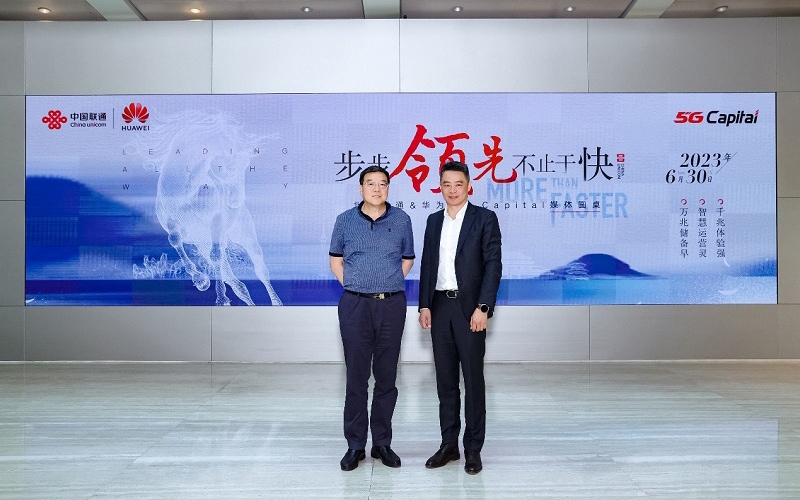At the Mobile World Congress (MWC) Shanghai 2023, China Unicom Beijing and Huawei showcased the achievements of their 5G Capital innovation project in the first half of 2023 at China Unicom's exhibition booth, following the fourth anniversary of the commercial rollout of 5G. Through the project, the partners have enhanced the reach, deep coverage, and experience of 5G networks, and proposed a definition for smart network operations. This definition, together with the previously-released user-experience-based criteria, forms a complete set of 5G network evaluation criteria, which will serve as a valuable reference for global operators when engaging in high-quality 5G planning, construction, maintenance, and optimization.

China Unicom Beijing and Huawei announcing their innovation achievements in 2023
Combining Static and Dynamic Elements to Enable Smart Networks and Network Operations
China Unicom Beijing and Huawei have been innovating and upgrading 5G networks to deliver better products and services to users. They verified 5G gigabit experience in hotspots in 2020, and tested the actual user experience across Beijing based on four categories of network evaluation criteria in 2021, with both achieving their desired results. In 2022, they deployed the world's largest 5G 200 MHz high-bandwidth urban network. For this year, they have been focusing on achieving smart operations based on the existing powerful network and service data in order to fully utilize the capabilities of the network and unleash its potential, thereby delivering premium user experience.
Smart operations, as China Unicom Beijing defines, require the combination of four static elements (most diverse dimensions, finest evaluation granularity, most comprehensive indicators, and optimal algorithm) and four dynamic elements (agile insight, smart algorithm, dynamic network, and flexible operations) to make networks intelligent. For example, for complex 3D scenarios such as buildings, stadiums, and residential areas, the minimum granularity of network evaluation is changed from cells to beams to gain accurate insights into 5G 3D coverage based on big data and smart algorithms. In addition, intelligent planning matches real-world network problems with engineering solutions to provide the most cost-effective planning solution. With the four dynamic elements, networks are capable of self-healing, self-optimization, and real-time response. Networks in operation can dynamically identify base station faults, accurately identify fault causes, and automatically adjust network parameters based on surrounding base stations and radio environments. In this way, the impact of faults on user experience is minimized, while the operations efficiency is maximized.
Yang Lifan, Deputy General Manager of China Unicom Beijing, said, "We put an AI brain into advanced networks to identify and solve every network pain point. We also maximize network efficiency using smart algorithms, achieve self-healing and self-optimization through dynamic networks, and improve user experience through flexible operations."
Consolidating All-Scenario 1 Gbps and Building 10 Gbps Capability into 5G Networks to Meet All Service Requirements
After four years of development, 5G networks are now in a stage of overcoming the challenges in achieving deep coverage in scenarios like residential areas, where last-100-meter coverage is required for providing premium experience and consolidating all-scenario 1 Gbps. Meanwhile, 5G network capabilities need to be upgraded to meet all service requirements, including upcoming new services, such as naked-eye 3D, New Calling, cloud phones, and 8K HD multi-channel live streaming.
China Unicom Beijing used Huawei's innovative solutions, including MetaAAU, EasyMacro, and Distributed Residential Solution (DRS), to build China's most powerful ubiquitous gigabit network in Beijing. This network increases 5G traffic by 50% and greatly improves 5G experience in residential areas. China Unicom Beijing also deployed Huawei's 5G high-band products, becoming the first to deploy such products in contiguous hotspots. Based on the extremely large antenna array (ELAA) technology, Huawei's 5G high-band products allow for live streaming using four 8K HD cameras at the same time, supporting a peak uplink rate of 2 Gbps. This makes China Unicom Beijing the first to be ready for the commercial use of the 10 Gbps capability.
Ritchie Peng, President of Huawei's 5G Product Line, said, "Since its launch four years ago, the 5G Capital project has helped us innovate and commercialize 5G technologies. As we gain a deeper understanding of product scenarios and key technology selection, we're able to provide optimal solutions for global operators. In addition to Massive MIMO, Huawei introduced a new technology — ELAA — in 2021. ELAA expands mid- and high-band coverage, helping us achieve deep coverage with C-band and put 5G high-band products into commercial use. I'm pleased to see that ELAA has enabled deep coverage in residential areas and continuous high-band coverage in hotspots. We will continue to innovate and help China Unicom Beijing build a quality network that is excellent in terms of speed and in every other aspect."
MWC Shanghai 2023 runs from June 28 to June 30 in Shanghai, China. Huawei will showcase its products and solutions at stands E10 and E50 in Hall N1 of Shanghai New International Expo Centre (SNIEC). Together with global operators, industry professionals, and opinion leaders, we dive into topics such as speeding up 5G prosperity, striding towards the 5.5G era, and intelligent digital transformation. 5.5G creates new business value in areas like connecting people, Internet of Things (IoT), and Internet of Vehicles (IoV), supporting countless industries as they move towards an intelligent world. For more information, please visit: https://carrier.huawei.com/en/events/mwcs2023.

 O-Sense
O-Sense







.png)

